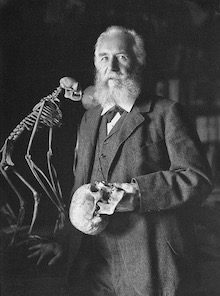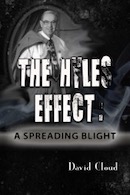866-295-4143, fbns@wayoflife.org
“Darwinism does not look you squarely in the eye” (Michael Pitman, Adam and Evolution, p. 217).
“When our leading scientists have to resort to the sort of distortion that would land a stock promoter in jail, you know they are in trouble” (Phillip Johnson, The Wall Street Journal, 1999).
“Forgeries and frauds are not all that uncommon in the science world” (Paul Chambers, Bones of Contention, p. 248).
“I believe that one day the Darwinian myth will be ranked the greatest deceit in the history of science” (Soren Lovtrup, Darwinism: The Refutation of a Myth).
“The impression that scientists think rationally and fairly is a simplistic myth. The fact is they are subject to the same human failings as the rest of us. Looking inside the ivory towers we find the familiar power establishments, personality conflicts, and intellectual blind spots brought about by philosophical presuppositions” (Ian Taylor, In the Minds of Men, p. 280).
“Within the English-speaking world, Darwin’s theory of evolution remains the only scientific theory to be widely championed by the scientific community and widely disbelieved by everyone else. No matter the effort made by biologists, the thing continues to elicit the same reaction it has always elicited: You’ve got to be kidding, right?” (David Berlinski, The Devil’s Delusion, p. 186).

Ernst Haeckel
Ernst Haeckel, inventor of the deceptive embryo chart and Java Man, also helped spread the Neanderthal myth. The first edition of his book History of Creation in 1868 featured a series of drawings depicting man evolving from apes--mandrill, monkey, gibbon, orangutan, chimpanzee, gorilla, Tasmanian, African Negro, Australian Negro, Fuegian, Chinese, Indo-German. Haeckel being German, placed his own “race” as the crown of evolution. In 1907, Haeckel described Neanderthal as a pre-human and placed him between Pithecanthropus (Java man) and Homo Australis, which he called “the lowest race of recent man.” This reflected Haeckel’s racist view that the Australian aborigines represented the lowest stage in full human evolution. Haeckel misrepresented Neanderthal’s brain capacity at 1270 cc, which is less than the average for modern man, when in reality the brain capacity was 1560 cc, which is larger than average.
After the discovery in 1908 of a nearly complete Neanderthal skeleton in La Chapell-aux-Saints in France, French paleontologist Marcellin Boule (1861-1942) of the Laboratory of Paleontology in the Museum of Natural History in Paris, added his authority to the evolutionary myth. Boule believed that Neanderthal was a branch of ape-men who became extinct without giving rise to modern humans. Between December 1908 and June 1909 Boule reported to the Academy of Sciences that Neanderthal was ape-like in many characteristics, including the skull and “a divergent great toe.” He believed that Neanderthal did not walk erect like modern man but walked pigeon-toed like an ape with a bent-knee gait.
In 1909, Frantisek Kupka drew a sketch of Neanderthal as a stooped, hairy ape-man gawking wildly with a club in his hand. It was published in the Illustrated London News.
In 1919, the famous author H.G. Wells said Neanderthal “stooped forward and could not hold his head erect … perhaps incapable of speech” (The Outline of History).
In 1930, Frederick Blaschke modeled a Neanderthal family in a cave setting, based on Boule’s interpretation. They were stooped, half-clothed, clutching bones, and had very unintelligent expressions. This was set up as a permanent display in the Field Museum of Natural History in Chicago and was copied in countless textbooks, encyclopedias, journals, popular magazines and newspapers, and museums.
This is the view that prevailed for nearly half a century, but it was pure speculation that went far beyond the actual evidence.
The prevailing view ignored the fact that Neanderthal skeletons had been found together with tools and weapons, and there was evidence of a developed social culture. They buried their dead (the La Chapell-aux-Saints man had been formally buried), used fire, constructed shelters, skinned animals.
The prevailing view also ignored the fact that there were “stone age” tribes of people in several parts of the world during the first half of the twentieth century that lived primitive lives but were obviously fully human, so there was no compulsion to label Neanderthal as some sort of missing link or pre-human. The fact is that the paleoanthropologists were blinded by their evolutionary zeal so that they saw what they wanted to see.
The prevailing view further ignored the fact, often pointed out by creationists and even some evolutionists, that there are people living today who look like the so-called Neanderthals--short and stocky, with heavy eyebrow ridges, etc. In fact, in 1910 a living specimen of a Neanderthal was found, “complete with the massive lower jaw, receding chin, heavy eyebrow ridges, small muscular frame, and short femur” (Taylor, In the Minds of Men, p. 211). The anatomist who carefully measured this individual also observed that the Tay Tay people of the Philippines display distinctive Neanderthal features (Taylor, p. 461). In fact, many Australian aboriginals also look like “Neanderthals.”
The prevailing view ignored, too, the fact that the brow-ridge of Neanderthal is clearly not that of an ape. “In the case of the ape, the prominent orbital ridge over the eyes is the result of the thickening of the edge of the bone over the eye; in the case of all men, including the Neanderthal Man, the brow-ridges are the result of the uniting of two bones, one of which is joined to the nose and the other to the opposite side” (Patrick O’Connell, Science of Today and the Problems of Genesis, 1959, p. 94).
After decades of parading the supposed ape-men Neanderthals before the world and influencing the thinking of millions of people, scientists finally gave the Neanderthal a second look. Since the 1960s, a new view of Neanderthal has gradually emerged.
Scientists now admit that Neanderthal could talk and he did not walk like an ape. He buried his dead, made musical instruments, used pain killing plants (“Dental plaque DNA,” UPI, Mar. 8, 2017), and in every other way lived like a normal human being.
A study of Neanderthal teeth by scientists from the University of Adelaide and the University of Liverpool has suggested that they even used antibiotics! Alan Cooper, corresponding author of the study, said, “Apparently, Neanderthals possessed a good knowledge of medicinal plants and their various anti-inflammatory and pain-relieving properties, and seem to be self-medicating. The use of antibiotics would be very surprising, as this is more than 40,000 years before we developed penicillin. Certainly our findings contrast markedly with the rather simplistic view of our ancient relatives in popular imagination” (“Neanderthals may have self-medicated with painkillers and penicillin,” New Atlas, Mar. 9, 2017).
Neanderthal has been reclassified as Homo sapiens neanderthalensis, a “sub type” of “modern man,” though some evolutionists still hold to the old classification.
A January 2010 editorial in The Guardian said, “It seems we have all been guilty of defaming Neanderthal man” (“In Praise of ... Neanderthal Man,” Jan. 13, 2010).
Indeed.
- Receive these reports by email
- www.wayoflife.org
______________________
Sharing Policy: Much of our material is available for free, such as the hundreds of articles at the Way of Life web site. Other items we sell to help fund our expensive literature and foreign church planting ministries. Way of Life's content falls into two categories: sharable and non-sharable. Things that we encourage you to share include the audio sermons, O Timothy magazine, FBIS articles, and the free eVideos and free eBooks. You are welcome to make copies of these at your own expense and share them with friends and family. You may also post parts of reports and/or entire reports to websites, blogs, etc as long as you give proper credit (citation). A link to the original report is very much appreciated as the reports are frequently updated and/or expanded. Things we do not want copied and distributed are "Store" items like the Fundamental Baptist Digital Library, print editions of our books, electronic editions of the books that we sell, the videos that we sell, etc. The items have taken years to produce at enormous expense in time and money, and we use the income from sales to help fund the ministry. We trust that your Christian honesty will preserve the integrity of this policy. "For the scripture saith, Thou shalt not muzzle the ox that treadeth out the corn. And, The labourer is worthy of his reward" (1 Timothy 5:18). Questions? support@wayoflife.org
Goal:Distributed by Way of Life Literature Inc., the Fundamental Baptist Information Service is an e-mail posting for Bible-believing Christians. Established in 1974, Way of Life Literature is a fundamental Baptist preaching and publishing ministry based in Bethel Baptist Church, London, Ontario, of which Wilbert Unger is the founding Pastor. Brother Cloud lives in South Asia where he has been a church planting missionary since 1979. Our primary goal with the FBIS is to provide material to assist preachers in the edification and protection of the churches.
Offering: Offerings are welcome if you care to make one. If you have been helped and/or blessed by our material offerings can be mailed or made online with with Visa, Mastercard, Discover, or Paypal. For information see: www.wayoflife.org/about/makeanoffering.html.





